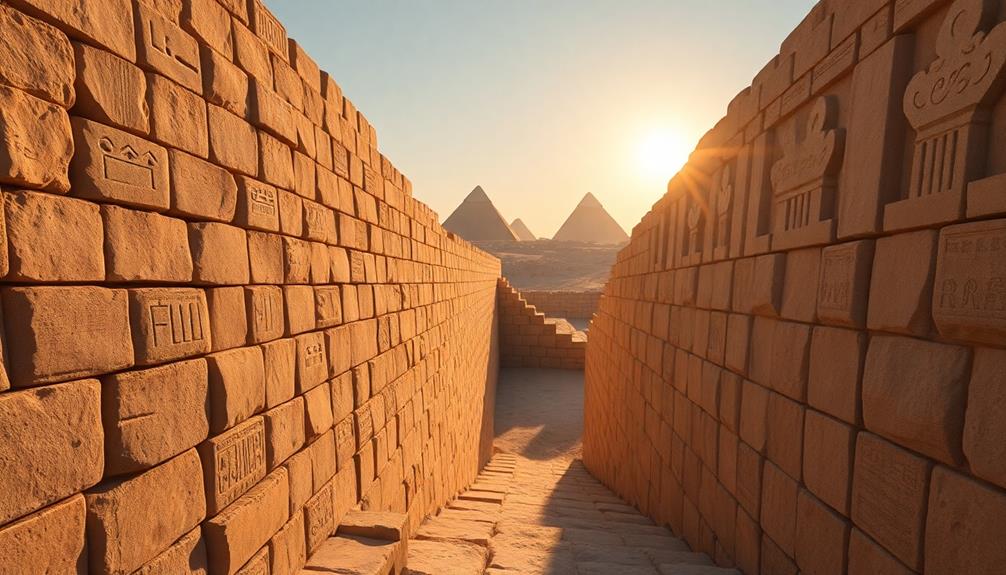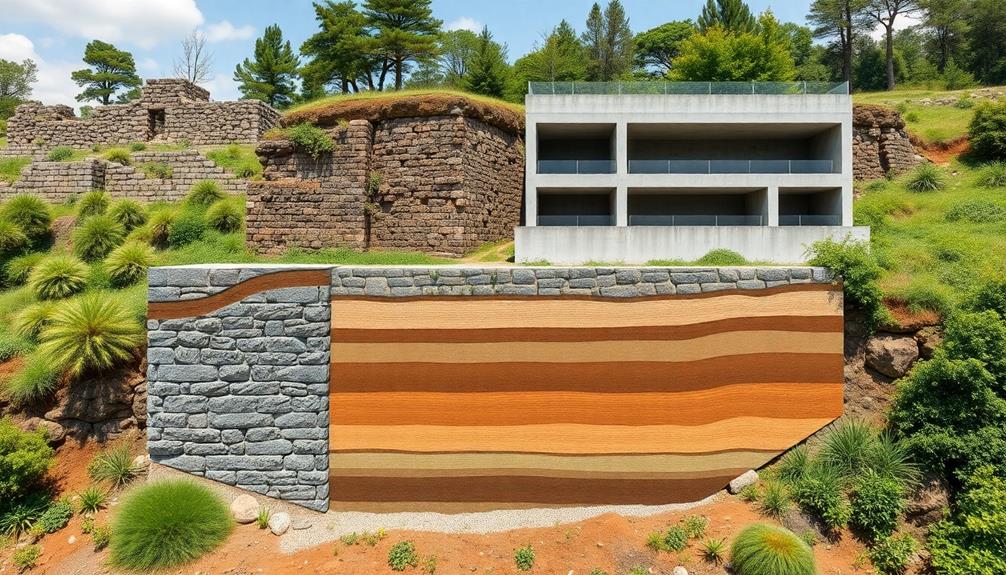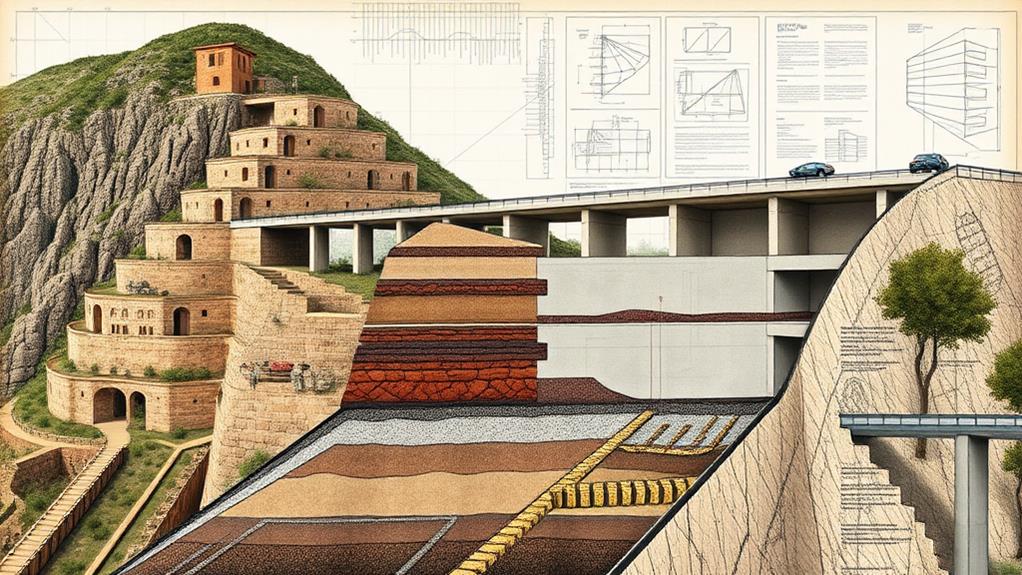The historical development of retaining wall engineering traces back to ancient civilizations, with notable advancements made by Egyptian and Mesopotamian builders. Ancient Egyptians pioneered precise limestone block construction techniques, utilizing sophisticated planning and execution methods to create structurally sound and weatherproof walls. Their mortar-free stacking techniques, employing dovetail joints and interlocking mechanisms, guaranteed the longevity of iconic structures. Mesopotamian innovations included stepped wall designs and ziggurat structural support techniques, which drastically improved stability and drainage systems. These ancient practices laid the foundation for modern retaining wall engineering, demonstrating the enduring importance of effective soil erosion prevention and land utilization strategies. Further exploration reveals the intricate details of these groundbreaking techniques.
Table of Contents
ToggleWalls Contractor Highlights
- Ancient Egyptians pioneered retaining wall techniques using precise limestone block construction and sophisticated engineering methods.
- Mortar-free stacking techniques, including dovetail joints and interlocking mechanisms, ensured structural integrity in early retaining walls.
- Hieroglyphic records provide insights into ancient engineering principles, measurements, and organizational structures for wall construction.
- Roman engineers advanced retaining wall technology with the introduction of concrete and arch designs.
- Medieval castle builders further developed retaining wall techniques for defensive structures and terrain management.
Ancient Egyptian Masonry Techniques

Ancient Egyptian masonry techniques provide valuable insights into early retaining wall construction methods. The Egyptians’ use of precisely cut limestone blocks, stacked without mortar, demonstrated remarkable engineering prowess and stability.
Hieroglyphic records offer a window into their construction processes, revealing sophisticated planning and execution techniques that have influenced masonry practices for millennia. Much like the granite company specialists of today, ancient Egyptians focused on structural integrity and weatherproofing to safeguard their walls against various weather conditions.
Limestone Block Construction Methods
Masterful engineering techniques employed by Egyptian builders have left an indelible mark on the history of masonry. Their limestone block construction methods, particularly in the creation of retaining walls, exemplify the ingenuity and precision of ancient craftsmanship. These skilled artisans utilized locally sourced limestone, meticulously cutting and shaping the blocks to guarantee a tight, interlocking fit.
The process began with the extraction of limestone from nearby quarries, where workers employed copper chisels and bronze saws to cut the stone into manageable sizes. Once transported to the construction site, stonemasons further refined the blocks, creating smooth surfaces and precise angles. The Egyptians implemented a sophisticated system of levers, ramps, and rollers to maneuver these massive stones into place.
To enhance stability, they employed a technique known as “ashlar masonry,” where blocks were laid in horizontal courses with staggered vertical joints. This method considerably increased the wall’s structural integrity and load-bearing capacity. Additionally, they utilized smaller stones and mortar to fill gaps between larger blocks, ensuring a solid, unified structure. These time-tested techniques continue to influence modern retaining wall engineering, demonstrating the enduring legacy of ancient Egyptian masonry.
Mortar-Free Stacking Techniques
Precision and ingenuity characterized the mortar-free stacking techniques employed by ancient Egyptian masons. These skilled artisans developed a sophisticated method of interlocking massive limestone blocks without the use of mortar, relying instead on the precise cutting and fitting of stones. This technique, known as ashlar masonry, allowed for the construction of monumental structures that have endured for millennia.
The process involved meticulously shaping each block to fit snugly against its neighbors, creating a stable and durable structure. Masons utilized copper chisels and bronze saws to achieve the necessary precision, often working with tolerances of less than a millimeter.
The blocks were typically arranged in horizontal courses, with each successive layer placed slightly inward to create a subtle inward slope. This design feature enhanced the wall’s stability and resistance to lateral forces. Additionally, the ancient Egyptians incorporated dovetail joints and other interlocking mechanisms to further strengthen the connections between blocks. These innovative techniques not only facilitated the construction of impressive retaining walls but also contributed to the longevity of iconic structures such as the pyramids and temples that continue to inspire awe and admiration to this day.
Hieroglyphic Construction Records
Hieroglyphic inscriptions provide invaluable insights into ancient Egyptian masonry techniques and construction practices. These detailed records, etched into stone and preserved for millennia, offer a window into the sophisticated engineering methods employed by master builders of the time. Through careful analysis of these hieroglyphics, modern scholars have deciphered pivotal information about the design and construction of monumental structures, including retaining walls.
The hieroglyphic records reveal several key aspects of ancient Egyptian masonry:
- Precise measurements and calculations used in planning and executing large-scale projects
- Specific tools and materials employed in the construction process, including specialized lifting and transportation equipment
- Organizational structures and labor management techniques utilized to coordinate massive workforces
These ancient inscriptions demonstrate the Egyptians’ advanced understanding of structural engineering principles, particularly in relation to retaining walls. The hieroglyphs describe methods for creating stable foundations, managing soil pressure, and incorporating drainage systems to prevent water accumulation behind walls. By studying these records, modern engineers can gain a deeper appreciation for the ingenuity of their ancient counterparts and potentially apply some of these time-tested techniques to contemporary retaining wall design and construction.
Benefits

Retaining walls offer numerous advantages in both natural and built environments. These structures excel at preventing soil erosion, a critical function that safeguards landscapes from degradation while simultaneously increasing the amount of usable land in sloped or uneven terrain.
Shoreline restoration projects often utilize retaining walls to protect waterfront properties from erosion and environmental factors, while also enhancing the aesthetic appeal of these areas. Beyond their practical applications, retaining walls contribute to enhanced structural stability in construction projects and can markedly improve the aesthetic appeal of landscapes, seamlessly blending functional engineering with architectural design.
Soil Erosion Prevention
One of the primary benefits of retaining walls is their effectiveness in preventing soil erosion. These structures play a pivotal role in stabilizing landscapes and protecting valuable topsoil from being washed away by wind, rain, and other environmental factors. By creating a physical barrier, retaining walls effectively manage water runoff and redirect it away from vulnerable areas, preserving the integrity of the surrounding terrain.
The soil erosion prevention capabilities of retaining walls are particularly valuable in the following scenarios:
- Steep slopes and hillsides, where the risk of landslides and soil displacement is high
- Coastal areas subject to wave action and tidal forces, which can rapidly erode shorelines
- Agricultural lands, where soil conservation is essential for maintaining crop productivity
Retaining walls contribute drastically to sustainable land management practices by reducing the need for frequent soil replacement and minimizing the environmental impact of erosion. Their implementation often results in long-term cost savings for property owners and municipalities alike. Additionally, these structures enhance the aesthetic appeal of landscapes while simultaneously fulfilling their indispensable protective function, making them an indispensable tool in modern civil engineering and land development projects.
Increased Usable Land
Beyond their soil erosion prevention capabilities, retaining walls offer another significant advantage: the creation of additional usable land. This benefit has been particularly valuable in urban and mountainous areas where space is at a premium. By constructing retaining walls, engineers and developers have been able to transform previously unusable slopes into functional, level surfaces suitable for a variety of purposes.
In urban environments, retaining walls have enabled the construction of multi-level parking structures, terraced gardens, and expanded building footprints. These structures have allowed cities to maximize their limited space, accommodating growing populations and infrastructural needs.
In rural and suburban settings, retaining walls have facilitated the development of hillside vineyards, expanded agricultural terraces, and created safe, level areas for recreational facilities.
The evolution of retaining wall engineering has played an essential role in land reclamation projects, transforming coastal areas and waterfront properties. By utilizing advanced materials and design techniques, engineers have been able to create stable, long-lasting structures that withstand the forces of nature while providing valuable new land for development. This increased usable land has not only enhanced property values but also contributed to the economic growth and sustainability of communities worldwide.
Enhanced Structural Stability
Enhancing structural stability stands as a primary benefit of well-designed retaining walls. These structures provide critical support to soil masses, preventing erosion and landslides while maintaining the integrity of surrounding landscapes.
As engineering techniques have advanced over time, retaining walls have become increasingly sophisticated in their ability to withstand various environmental pressures and geological challenges.
The evolution of retaining wall design has led to significant improvements in structural stability, including:
- Integration of geotextiles and reinforcement materials to distribute loads more effectively
- Development of advanced drainage systems to mitigate hydrostatic pressure
- Implementation of computer-aided design tools for precise stress analysis and optimization
These advancements have resulted in retaining walls that not only perform their primary function of soil retention but also contribute to the overall stability of adjacent structures and infrastructure.
By incorporating modern engineering principles, retaining walls now offer enhanced resistance to seismic activity, extreme weather events, and long-term settlement issues. This increased dependability guarantees the longevity of constructed environments and provides peace of mind for property owners, developers, and communities alike.
As a result, retaining walls have become indispensable components in urban planning, transportation infrastructure, and landscape architecture, fostering a sense of security and permanence in our built environment.
Aesthetic Landscape Improvement
While retaining walls primarily serve functional purposes, they also offer significant aesthetic benefits to landscapes. These structures, when thoughtfully designed and integrated into the environment, can transform ordinary outdoor spaces into visually striking and cohesive landscapes.
Retaining walls provide opportunities to create multi-level gardens, terraced patios, and elevated seating areas, adding depth and dimension to otherwise flat or sloping terrain. By incorporating various materials such as natural stone, brick, or textured concrete, designers can complement existing architectural styles and enhance the overall visual appeal of a property.
Furthermore, retaining walls can be used to frame and highlight specific landscape features, such as water elements, flower beds, or specimen plants. They serve as effective backdrops for ornamental vegetation, creating a harmonious blend of hardscape and softscape elements. In urban environments, these structures can mitigate the visual impact of necessary grade changes, seamlessly integrating buildings with their surroundings.
Buttressing Innovations in Mesopotamia

Ancient Mesopotamian engineers pioneered innovative buttressing techniques that revolutionized retaining wall construction. Their early stepped wall designs, exemplified by the iconic ziggurats, provided enhanced structural support and stability for massive earthen structures. These advancements were further complemented by sophisticated drainage systems, which mitigated water damage and erosion, ensuring the longevity of their architectural marvels.
| Innovation | Description | Impact |
|---|---|---|
| Stepped Walls | Terraced design with progressively smaller levels | Increased stability and load distribution |
| Ziggurat Support | Solid core with external buttressing | Enhanced structural integrity for tall structures |
| Advanced Drainage | Integrated channels and porous materials | Reduced water pressure and erosion risks |
| Material Selection | Use of fired bricks and bitumen | Improved durability and weather resistance |
| Foundation Techniques | Deep, compacted earth foundations | Greater load-bearing capacity and settlement reduction |
Early Stepped Wall Designs
Pioneering structural innovations in Mesopotamia gave rise to early stepped wall designs, marking a significant advancement in retaining wall engineering. These novel structures emerged as a response to the region’s challenging terrain and the need for more robust fortifications.
The stepped wall design incorporated several key features that set it apart from earlier, simpler retaining walls:
- Graduated tiers: The wall was constructed in a series of progressively narrower levels, distributing the lateral earth pressure more effectively.
- Improved stability: The stepped profile increased the wall’s resistance to overturning and sliding, enhancing its overall structural integrity.
- Efficient material usage: This design allowed for the strategic placement of heavier stones at the base, with lighter materials used in upper tiers.
The adoption of stepped wall designs represented an essential milestone in the evolution of retaining wall engineering. These structures not only provided enhanced protection for ancient Mesopotamian cities but also laid the foundation for future advancements in civil engineering. The principles underlying stepped wall construction continue to influence modern retaining wall design, demonstrating the enduring legacy of these early innovations.
Ziggurat Structural Support Techniques
The stepped wall designs of early Mesopotamia paved the way for more ambitious architectural endeavors, particularly the construction of ziggurats. These monumental structures, serving as both religious centers and symbols of power, required innovative structural support techniques to achieve their impressive heights and stability.
Mesopotamian engineers developed sophisticated buttressing systems to reinforce the ziggurat’s core. These systems involved the strategic placement of reinforcing walls perpendicular to the main structure, effectively distributing the immense weight and lateral forces. The outer layers of the ziggurat were typically constructed using sun-dried mud bricks, with fired bricks employed for added durability in areas exposed to weathering. To enhance structural integrity, builders incorporated layers of reed mats between brick courses, providing flexibility and mitigating the effects of settling and earthquakes.
Furthermore, engineers implemented an intricate drainage system within the ziggurat’s core to manage water infiltration and prevent erosion. This system consisted of a network of channels and pipes that diverted rainwater away from the structure’s foundation, ensuring long-term stability. The combination of these advanced techniques allowed for the creation of awe-inspiring structures that have endured for millennia, showcasing the ingenuity of ancient Mesopotamian engineering.
Drainage System Advancements
Mesopotamian engineers made significant strides in drainage system technology, building upon their ziggurat construction expertise. These advancements were essential for maintaining the structural integrity of retaining walls and preventing water-induced damage. The innovative drainage techniques developed during this period laid the foundation for modern water management systems in civil engineering.
Key improvements in Mesopotamian drainage systems included:
- Stepped drainage channels: Engineered to control water flow along the face of retaining walls, reducing erosion and hydrostatic pressure.
- Perforated clay pipes: Embedded within walls to facilitate water evacuation, preventing buildup and potential structural weakening.
- Graded aggregate backfill: Carefully layered behind walls to promote natural filtration and dispersion of water.
These advancements not only enhanced the longevity of retaining walls but also demonstrated the Mesopotamians’ deep understanding of hydraulic principles. By implementing these sophisticated drainage systems, engineers effectively mitigated the risk of wall collapse due to water accumulation and soil saturation. The integration of these techniques into ziggurat and city wall construction exemplified the Mesopotamians’ commitment to sustainable and resilient infrastructure, setting a precedent for future civilizations’ approaches to water management in large-scale architectural projects.
Walls Contractor FAQ
How Do Modern Building Codes Impact Retaining Wall Design and Construction?
Modern building codes markedly influence retaining wall design and construction by mandating safety standards, structural integrity requirements, and environmental considerations. These regulations guarantee our communities benefit from durable, reliable structures that protect both property and lives.
What Role Does Soil Composition Play in Retaining Wall Effectiveness?
Soil composition greatly influences retaining wall effectiveness. Together, we consider factors like soil type, moisture content, and compaction. Understanding these elements helps us design walls that provide excellent stability and longevity for our shared built environment.
Are There Eco-Friendly Alternatives to Traditional Retaining Wall Materials?
Eco-friendly retaining wall alternatives include gabion walls with recycled materials, living walls with vegetation, and timber walls from sustainable sources. These options offer environmentally conscious solutions that align with our shared values of environmental stewardship and community responsibility.
How Do Seismic Considerations Affect Retaining Wall Engineering in Earthquake-Prone Regions?
Seismic considerations greatly impact retaining wall design in earthquake-prone regions. Engineers must account for dynamic lateral earth pressures, soil liquefaction potential, and structural flexibility. Our community of professionals employs advanced analysis techniques and reinforcement strategies to guarantee wall stability during seismic events.
What Are the Maintenance Requirements for Different Types of Retaining Walls?
Retaining wall maintenance varies by type. Regular inspections, drainage system upkeep, and vegetation control are essential for all walls. Our community of engineers recommends addressing cracks, soil erosion, and structural issues promptly to guarantee long-term stability and safety.







